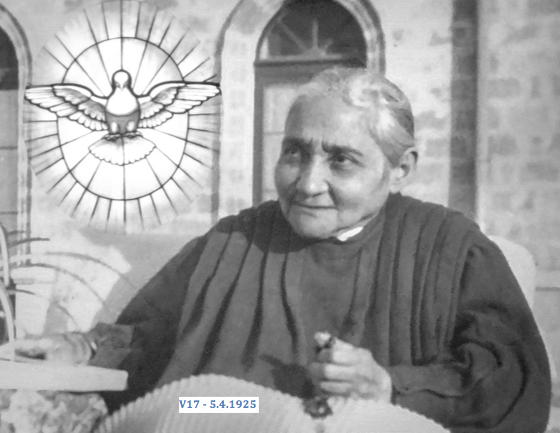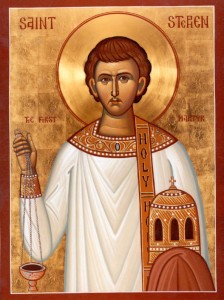St. Stephen, First Martyr
St. Stephen is the first of the witnesses of Christ; it is only right that he could appear first in the glorious processions of Saints who surround the cradle of the Savior.
Yesterday, the Lord of the universe filled us with wonder, whereas today the disciple of the Lord fills us with wonder. In what manner the former, and in what manner the latter? The former (i.e. Christ), for our sakes assumed human nature, while the latter (i.e., St. Stephen) for the sake of the Lord rid himself of human nature. The martyr’s death of St. Stephen is truly singular, as is his cult, which is enjoyed in the Church of Christ since apostolic times.
St. John Chrysostom numbers St. Stephen among the apostles: “Tell me truthfully,” he says, “what did he lack to be equal to the Apostles? Did he not also work miracles? Did he not also manifest fortitude?” (Sermon 15)
Accused before the Synhedrion – the Jewish Council – by false witnesses, St. Stephen bravely professed the Holy Faith. For this they led him out of the city and stoned him to death. This occurred in the year 34 or 35 (A.D.) after Christ. Like Christ, St. Stephen too prayed for his enemies at his death. Saul, a young man who later became the Apostle Paul, took part in his martyrdom. St. Agustine ascribes the conversion of Saul to the martyrdom of St. Stephen. “If Stephen had not prayed,” he says, “the Chruch would not now have Paul.” St. Stephen was the first to shed his blood and give up his life after the Ascension of Our Lord.
St. John Chrysostom begins his sermon on St. Stephen with the words: “All the Martyrs are given glory, and the heroic deeds of the Just are everywhere an object of admiration; but at the meniton of the most famous heroic deed of the first-martyr Stephen, even the mute tongue begins to praise him. Whom is Blessed Stephen not able to invite to praise (him)? His very name, which in Greek means “crown”, already indicates his merits. His very name suggests that he received the honor of victory! Here the name of the Martyr already implies struggle, victory, and honor!”
Another sermon on St. Stephen says: “We crown Stephen with flowers of praise, and we shower upon him roses of laudatory songs. He already crowned himself with victorious prizes . . . . Who among mortals can give worthy praise to the fighter? Who of us is able to weave a wreath fitting his heroic deed? What tongue is able to expound the glory of the victor? What lips shall speak in praise of the heroic deeds of St. Stephen? What mouth is able to express the fortitude of the first Martyr?”
St. Stephen was first among the seven deacons chosen to take care of the poor. He is the first-martyr and prototype of all martyrs and so his cult is the oldest of all the martyrs. The Holy Church linked his memory with the feast of the Nativity of Our Lord for, as the first-martyr of Christ, he bore a very close relation with Christ.
The Feast of St. Stephen was already generally known in the fourth century and was celebrated on an equal footing with those of the Apostles. The Apostolic Constitutions of the fourth century say: “Let them celebrate on the day of the first-martyr Stephen.” The Holy Fathers of the fourth century, such as St. Gregory the Theologian, St. Gregory of Nyssa, St. John Chrysostom and St. Augustine, preached sermons in honor of St. Stephen. In the fourth and fifth centuries, churches were built in his honor.
A further mote for the cult of St. Stephen was the finding of his relics in 415. It was then that according to tradition the teacher of the Apostle Paul, who died believing in Christ, appeared three times to a priest of Jerusalem, Lucianus. He told Lucianus that, after the stoning of Stephen, he buried Stephen’s body in his own tomb, where it now rests together with the remains of his son, Avivus, and near them Nicodemus – the secret disciple of Christ. The discovered relics of St. Stephen were transferred to the church on Sion, in Jerusalem. Sometime afterwards they were again transferred to the Church of the Stoning, north of Jerusalem. The wife of Emperor Theodosius the Younger, Eudokia, in the year 460, at the place of the original Church of the Stoning, built a beautiful basilica which was later destroyed. The ruins of this basilica were discovered in 1812, and upon the old foundation the present day church of St. Stephen was erected.
In the year 560 part of the relics of St. Stephen were transferred to Constantinople and deposited, first in the church of St. Lawrence, and later in the newly built church of St. Stephen. Just as at the finding, so too, at the translate of the relics of St. Stephen, various miracles took place. St. Augustine, the great venerator of St. Stephen, speaks of these miracles.

